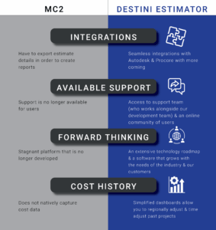The Future of BIM in Preconstruction: What’s Next?

Building Information Modeling (BIM) has transformed the construction industry over the past few decades. While initially considered a tool for the later stages of the construction process, its role in preconstruction planning has grown considerably, impacting project efficiency, design collaboration, and cost management. BIM's integration into preconstruction reshapes how project teams approach complex construction projects from conception to completion. However, as technology continues to evolve, the future of BIM in preconstruction is poised to be even more transformative.
Let’s explore the evolving role of BIM in preconstruction, examining how Building Information Modeling enhances preconstruction planning and boosts efficiency in the construction industry. We’ll also look into the future of BIM and how it will shape how we design, plan, and manage construction projects.
What is BIM in Construction?
Building Information Modeling (BIM) is a digital process that involves creating detailed 3D models of a building's physical and functional characteristics. These models go beyond simple 3D visuals by embedding information about building components, materials, and systems, which is useful for construction management, planning, and long-term operation and maintenance.
The process involves integrating data, workflows, and technologies throughout a project's lifecycle. This process enables the project team to collaborate efficiently and share a unified building model that serves as the project's single source of truth. It helps stakeholders across the architecture engineering and construction (AEC) industries better understand the design, minimize risks, and reduce waste and inefficiencies during preconstruction and construction.
Enhancing Preconstruction with BIM
Preconstruction planning involves all activities that take place before actual construction begins. This stage includes the development of designs, cost estimates, project schedules, and risk assessments. In this phase, BIM in construction is essential for improving accuracy, reducing errors, and ensuring that projects are delivered on time and within budget.
1. Streamlined Collaboration
The complexity of today’s construction projects demands close collaboration between various stakeholders—architects, engineers, contractors, subcontractors, and more. With BIM, these teams can collaborate in a shared digital environment. Accessing a digital representation of the building model in real time allows for better communication between all involved parties. Changes made to the model by one team member are immediately seen by all team members, improving the coordination of the project.
This collaborative environment reduces silos, minimizes misunderstandings, and ensures that all team members have access to the latest version of the design, which helps in more effective decision-making during preconstruction.
2. Accurate and Detailed Cost Estimates
One of the most critical aspects of preconstruction is creating cost estimates. Estimating costs accurately at the early stages can make the difference between a successful project and a cost-overrun disaster. BIM enables more precise cost estimation by using real-time data extracted from the building components in the model. BIM software allows estimators to calculate material quantities, labor costs, and other expenses with great precision.
DESTINI Estimator is a leading software tool for cost estimation that integrates seamlessly with BIM models. It helps cost estimators create detailed, data-driven budgets while ensuring that all project components, from the foundation to the roof, are accounted for. This integration enhances the accuracy of early-phase budgeting and reduces the likelihood of unexpected cost overruns later in the project.
3. Risk Reduction and Improved Scheduling
BIM helps mitigate risks early on by allowing project teams to visualize potential problems before they occur. Whether it’s conflicting building components, site constraints, or accessibility issues, BIM enables the project team to identify and resolve issues before construction begins. Using 3D models and digital representations of the site, teams can simulate and test the construction process, predicting potential bottlenecks and inefficiencies in scheduling.
The detailed information provided by BIM also helps with accurate scheduling. Project managers can map out a construction project's timeline with precision, reducing delays and ensuring that the work proceeds according to plan.
4. Enhanced Design and Planning Flexibility
BIM’s real-time collaboration tools allow project teams to iterate and refine designs faster than with traditional methods. Changes to the design can be made quickly and accurately, ensuring stakeholders are always working with the most up-to-date version of the building model. Additionally, designers can run simulations and virtual walkthroughs to understand better how the building will function in the real world, making modifying the design to meet the client’s goals and specifications easier.
This flexibility is important in preconstruction as it helps avoid costly changes. The ability to adapt quickly during the planning phase can save both time and money.
5. Integration with Other Technologies
BIM is increasingly integrated with other emerging technologies to enhance preconstruction planning further. Virtual Reality (VR) and Augmented Reality (AR) visualize projects in immersive 3D environments. Project stakeholders can explore a virtual version of the project before construction begins, making it easier to identify issues and make design decisions early in the process.
Additionally, drones and laser scanning technologies are being integrated into BIM workflows to capture real-world data and feed it directly into the building information modeling BIM system. This level of integration enables the most accurate model possible, ensuring that the construction process is based on precise, up-to-date information.
The Role of BIM in the Future of Construction Management
BIM's role in construction management will continue to expand as technology advances. The future of BIM will likely involve greater integration with artificial intelligence (AI) and machine learning. These technologies can help with predictive analytics and improve project planning by identifying potential risks or inefficiencies before they arise.
As the AEC industries continue to embrace digital transformation, BIM will become an even more vital part of the construction process. For instance, BIM will likely play an increasing role in operation and maintenance after the building is completed. Facilities managers can use BIM models to maintain the building, make repairs, and plan for future upgrades. This will extend the life of the building and optimize operational costs.
Another exciting area for the future of BIM in preconstruction is the rise of smart buildings. Integrating IoT (Internet of Things) devices into BIM models allows buildings to monitor and adjust their systems (such as HVAC or lighting) in real time based on usage patterns. This can enhance building performance and reduce energy consumption.
What’s Next for BIM in Preconstruction?
Looking ahead, we can expect greater emphasis on integrating BIM into construction industry standards and practices. As more projects adopt BIM, we will likely see a unified set of standards for information sharing, helping streamline workflows and ensuring operability between different BIM platforms and software.
We also believe that BIM accessibility will improve. While it used to be an expensive, complex tool that required significant investment, cloud-based BIM solutions are now more affordable and accessible to small and medium-sized construction firms. This will enable a larger portion of the project team to benefit from the tool, leading to more innovative and efficient construction practices across the industry.
BIM will also benefit the growing demand for sustainability and eco-friendly design in construction projects. By simulating energy usage, material efficiency, and building performance before construction begins, BIM helps ensure that buildings are designed and constructed sustainably.
BIM Will Help Shape Construction Management
BIM has already proven its value in preconstruction, revolutionizing how the construction process is managed, planned, and executed. As technology continues to evolve, the future of BIM will be more promising, with greater integration, more advanced features, and improved accessibility.
The continued adoption of BIM, including tools like DESTINI Estimator, will enable construction professionals to estimate costs more accurately, plan projects more effectively, and collaborate more effectively. As the industry embraces BIM, the future of construction management will be smarter, more sustainable, and more efficient.
The potential benefits of BIM and construction management are undeniable, and as new tools and technologies emerge, BIM in construction will become even more critical to ensuring the success of construction projects in the years to come.

-1.png?width=112&height=112&name=image%20(4)-1.png)














